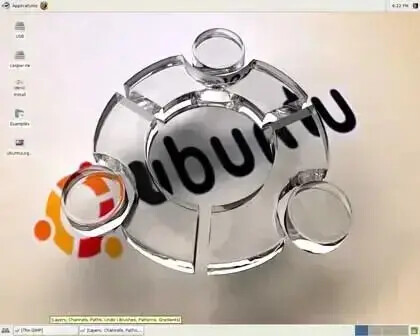
USB XUbuntu 6.10 This tutorial enables a user to install, boot and run Ubuntu from a USB flash thumb drive. By utilizing multiple partitions, the user can save changes and settings back to the flash thumb drive. Ubuntu is based on Debian Linux and is one of the more user friendly and stable releases. Ubuntu’s slogan is (it should “Just Work”, TM)
USB XUbuntu 6.10 Linux Screenshot:

Basic essentials:
- 1GB or larger USB flash drive
- Bootable Ubuntu Live CD
- USBubuntu.zip
Warning: DO NOT run makeboot.exe from your local hard drive!! It is intended to be run from your USB device. This tutorial requires you to reformat and partition your USB device. Please backup any information that may be on your USB device before proceeding.
The tutorial:
- Download the Ubuntu 6.10 ISO and burn it to CD
- Download the USBubuntu.zip
- Insert the XUbuntu Live CD and reboot your computer (boot from XUbuntu)
- Insert a 1GB or larger USB flash drive
- Open a terminal window and type sudo su
- Now type fdisk -l to list available drives/partitions (note which device is your flash drive typically /dev/sda)
- type umount /dev/sda1 (replacing sda1 with your flash drive partition)
- type fdisk /dev/sda (again replacing sda with your device)
- type p to show the existing partition and d to delete it
- type p again to show any remaining partitions (if partitions exist, repeat step 3)
- type n to make a new partition
- type p for primary partition
- type 1 to make this the first partition
- hit enter to use the default 1st cylinder
- type +700M to set the partition size
- type a to make this partition active
- type 1 to select partition 1
- type t to change the partition filesystem
- type 6 to select the fat16 file system
- type n to make another new partition
- type p for primary partition
- type 2 to make this the second partition
- hit enter to use the default cylinder
- hit enter again to use the default last cylinder
- type w to write the new partition table
- Type umount /dev/sda1 (replacing with your partition) to unmount the partition
- Type mkfs.vfat -F 16 -n USB /dev/sda1 to format the first partition (replace sda1 with your partiton)
- “Alternately you can try mkfs.vfat -F 32 -n USB /dev/sda1 (doesn’t always work)”
- Type mkfs.ext2 -b 4096 -L casper-rw /dev/sda2 to format the second partition (replace sda2 if necessary)
- Reboot your computer (boot back into Windows)”make sure to remove the XUbuntu CD”
- Extract the contents of the USBubuntu.zip to your “flash drive”.
- Browse to your “flash drive” and click the Makeboot.exe
- follow the on screen instructions.
- Reboot your computer and set your system BIOS to boot from USB-HDD or USB-ZIP. Also set the boot priority if necessary.
Ubuntu is notoriously much slower to boot than other linux versions. Once Ubuntu is up and running, it is stable and snappy.
Please note: This tutorial has been tested to work from a Windows XP computer. The .Net framework is required in order to run the Makeboot.exe application. You can download .Net framework Here
Geen opmerkingen:
Een reactie posten